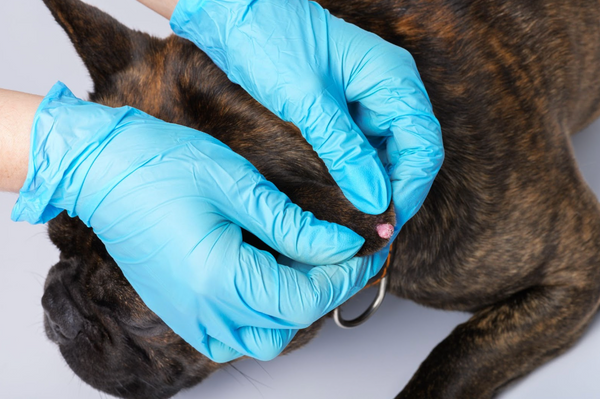What are these lumps & bumps on my dog?

When you see or feel a bump on your dog, the immediate reaction is to be alarmed and scared. You’re a dog parent after all. It’s in your code to be on top of your dog’s health. But what you might not know is that dogs, just like humans, can experience a variety of lumps and bumps.
The big question is…how do you know if the bump is bad or harmless? In this blog post, we look at several types of lumps and bumps that dogs may get while they’re in your care. You’ll also get some tips on what to do and what practices to follow to help your pup.
Keep in mind that it’s always best to have a trusted veterinarian examine your dog if any concerns come up, like these bumps.
Let’s start from the top!
Types of Lumps & Bumps
There are several lumps and bumps that can form on your dog. They include but are not limited to:
- Lipomas
- Cysts
- Warts
- Skin tags
- Abscesses
- And tumors
Lipomas
As dogs get older, and/or if they become overweight, they might experience growths on their skin called lipomas. These are fatty deposits under the skin, forming round lumps. The good news is that lipomas are always non-cancerous. The bad news is that you’re still going to take a trip to the veterinarian so they can do a sample and confirm it is non-cancerous.
Cysts
When glands are blocked and fluids build up, cysts may form. These lumps may look like pimples but can also grow larger in size. If it becomes uncomfortable for your dog, your veterinarian may recommend surgery to remove the cyst.
Warts
According to Positive Pooches, “Certain viruses can cause the growth of small round skin tumors commonly referred to as Puppy Warts. Even though dogs can get warts, they are not caused by the same virus that causes them in humans. These are benign skin tumors caused by the Canine Oral Papilloma Virus.”
“Viral papillomas are round, but often have a rough, almost jagged surface - like a cauliflower,” they explain. “They generally occur on the lips and muzzle of a young dog (typically less than 2 years of age). Less commonly, papillomas can occur on the ears, eyelids, and even the surface of the eye, or between the toes. They often occur in groups.
Skin Tags
These are little lumps of flesh caused by overactive cells and dogs of all ages, breeds, and sizes can experience this. Just like lipomas, your veterinarian may want to confirm it’s non-cancerous, especially if the skin tag is changing shapes and colors.
Abscesses
When dogs experience abscesses, it’s because of an infection. So the culprit can range from a bug bite to other sores that don’t heal. It’s important to see your veterinarian because if the abscesses continue, they can burst and cause more pain to your pup.
Tumors
The two common tumors that dogs may face are button tumors and mast cell tumors. The main difference is that the button tumors occur with puppies and often disappear on their own, while mast cell tumors are cancerous.
According to AKC, “They’re often solid to the touch and irregular in shape. The appearance of such a tumor should receive immediate attention from a veterinarian. They’ll likely want to remove the tumor, if possible, before performing a biopsy to determine if cancer might have spread through your dog’s body. If surgical removal isn’t possible, you may be referred to a veterinary oncologist for chemotherapy or radiation treatment.”
What To Do
It’s always a good idea to read up on as much as possible, but always get confirmation from a veterinarian. Your vet can do a thorough examination of your dog, look at any lumps or bumps of concern, and treat them. Treatment can range from antibiotics to surgical procedures and radiation therapy.
A Good Practice To Follow
Because lumps and bumps can be hard to find, this is another reason why grooming is so important. Keeping up with your dog’s sanitary grooming, keeping their fur trimmed and maintained, can help you keep a close watch for bumps that shouldn’t be there.
This is just a sampling of tips and informational posts we offer at Joyride Harness. You can find more content including tips and tricks and how-tos for caring for your dog on our blog at this section. Feel free to leave a comment with tips you’re looking for!

























